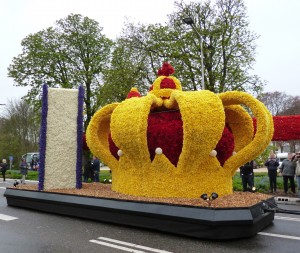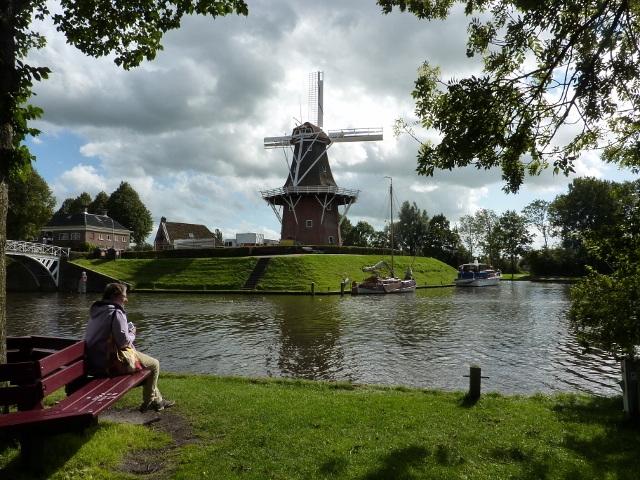 Having had a favorable exploratory look at Holland during mid summer a couple of years back we decided to head there again for an extended tour, only this time in September. The idea being to enjoy the peace and quiet of slightly off season campsites and places of interest. Good move on the peaceful front, not so good on the weather, the tail-end of the hurricane which had been creating havoc along the east coast of America, decided to blow itself out across northern Europe (Sep.2011). After the usual swift and calm Euro-tunnel crossing our first couple of nights were spent in Belgium on the outskirts of Gent.
Having had a favorable exploratory look at Holland during mid summer a couple of years back we decided to head there again for an extended tour, only this time in September. The idea being to enjoy the peace and quiet of slightly off season campsites and places of interest. Good move on the peaceful front, not so good on the weather, the tail-end of the hurricane which had been creating havoc along the east coast of America, decided to blow itself out across northern Europe (Sep.2011). After the usual swift and calm Euro-tunnel crossing our first couple of nights were spent in Belgium on the outskirts of Gent. 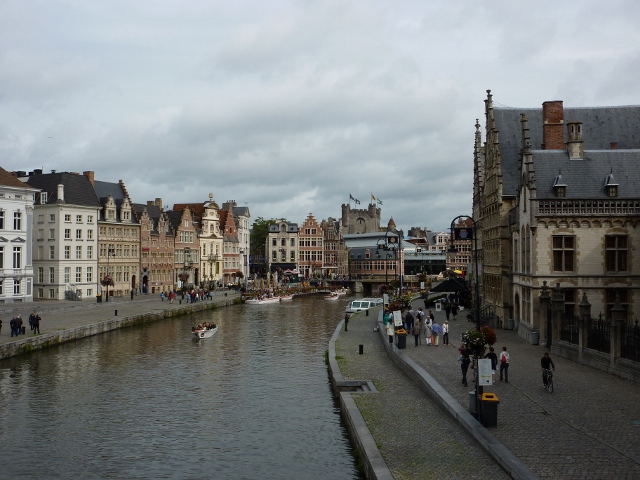
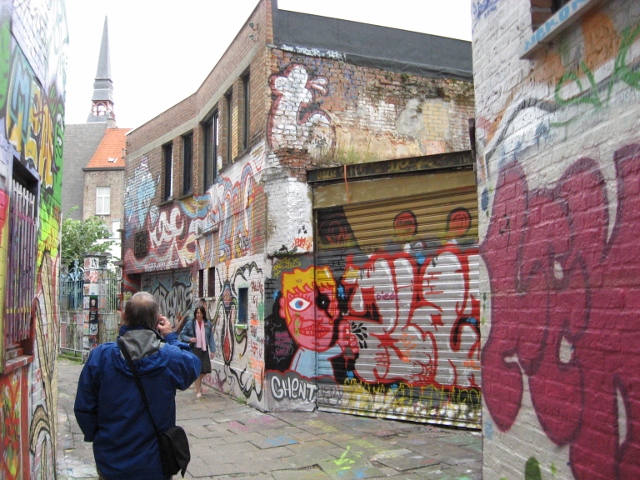 After an evening and night of thunder-storms the morning promised a bright day for a bus ride (no.39 outside the site) into the ancient town. Our arrival was perfect, all the infamous city-centre road/tram works were complete and it is now all pedestrian friendly, just watch out for the bikes. The bus can drop you bang in the centre of the historic quarter alongside the central canal. From here you can take a tour boat cruise narrated in your native language, although we thought we would see more by strolling with our free map from the helpful Tourist Office. The size and decoration of the buildings were most impressive. Lots of side streets entice you to wander; from most you could see the well preserved castle. One unusual street was covered with legal graffiti. In the corner of the main square there is a quaint bakers which sells amongst its buns and breads a delicious chocolate bread, highly recommended.
After an evening and night of thunder-storms the morning promised a bright day for a bus ride (no.39 outside the site) into the ancient town. Our arrival was perfect, all the infamous city-centre road/tram works were complete and it is now all pedestrian friendly, just watch out for the bikes. The bus can drop you bang in the centre of the historic quarter alongside the central canal. From here you can take a tour boat cruise narrated in your native language, although we thought we would see more by strolling with our free map from the helpful Tourist Office. The size and decoration of the buildings were most impressive. Lots of side streets entice you to wander; from most you could see the well preserved castle. One unusual street was covered with legal graffiti. In the corner of the main square there is a quaint bakers which sells amongst its buns and breads a delicious chocolate bread, highly recommended. 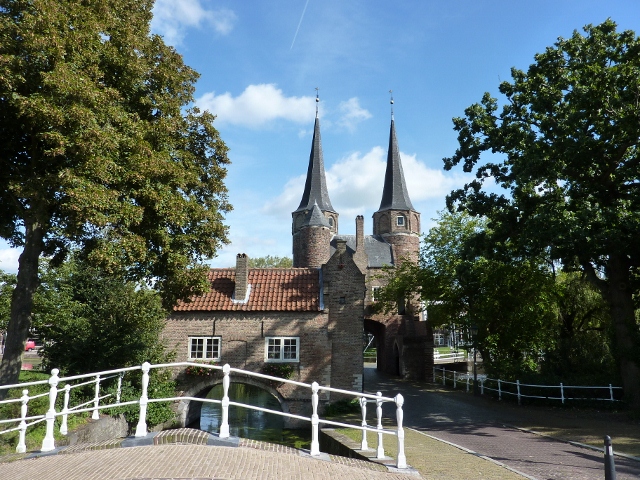 Moving north into Holland, or The Netherlands to give it its proper name, past Breda and Rotterdam on the brilliantly smooth and efficient toll-free motorways we arrived at the charming town of Delft. Camping Delftse Hout was our very convenient site for strolling over the various canals into this home of Delft china-ware. Every other shop in and around the lovely central square obviously sells the famed blue and white china, although the cheaper touristy pieces are all made in China; there are four local factories producing the finer pieces.
Moving north into Holland, or The Netherlands to give it its proper name, past Breda and Rotterdam on the brilliantly smooth and efficient toll-free motorways we arrived at the charming town of Delft. Camping Delftse Hout was our very convenient site for strolling over the various canals into this home of Delft china-ware. Every other shop in and around the lovely central square obviously sells the famed blue and white china, although the cheaper touristy pieces are all made in China; there are four local factories producing the finer pieces. 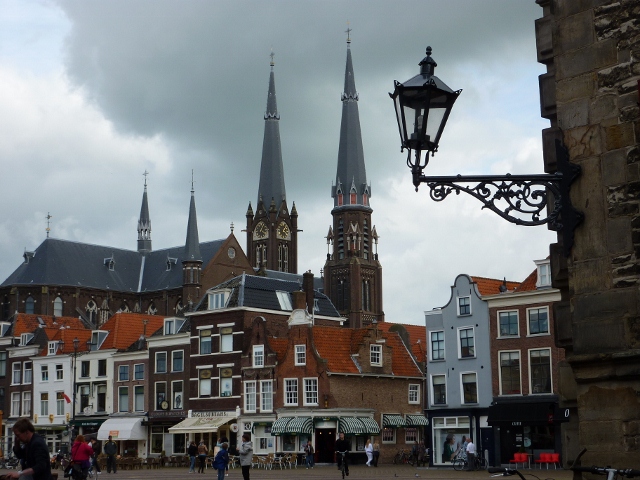
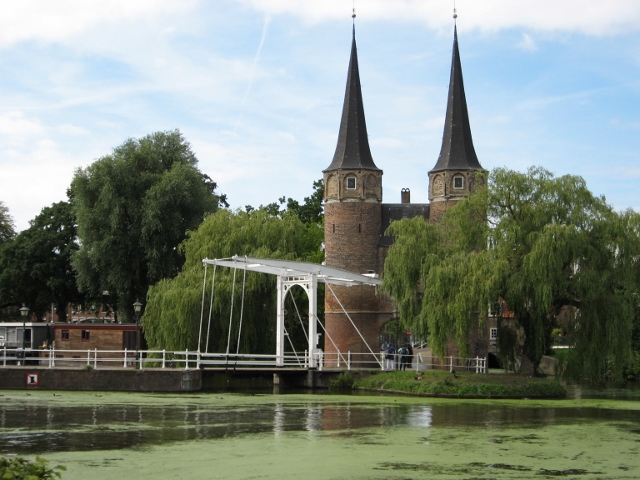
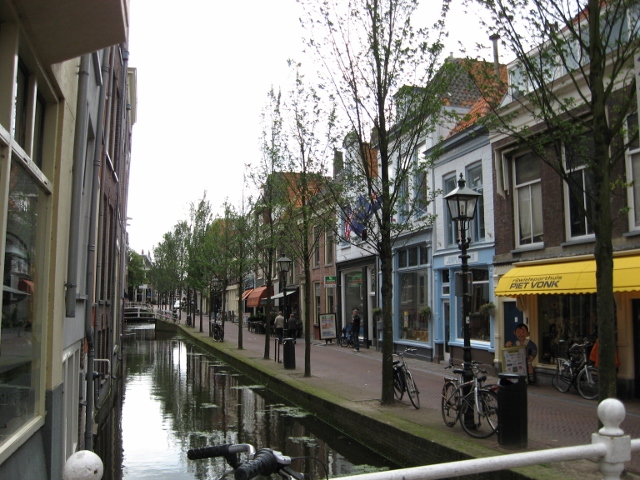 The whole town has an air of peace and calm helped by the numerous cafes and drinking places around every corner. After walking alongside the tree lined canals you could visit the 14th.century Nieuwe Kerk. This church contains the crypt of the Dutch royal family. We spent a leisurely hour in the small Botanic Gardens where on the steamy Tropical glasshouse floor a family of dainty Quails were living.
The whole town has an air of peace and calm helped by the numerous cafes and drinking places around every corner. After walking alongside the tree lined canals you could visit the 14th.century Nieuwe Kerk. This church contains the crypt of the Dutch royal family. We spent a leisurely hour in the small Botanic Gardens where on the steamy Tropical glasshouse floor a family of dainty Quails were living. 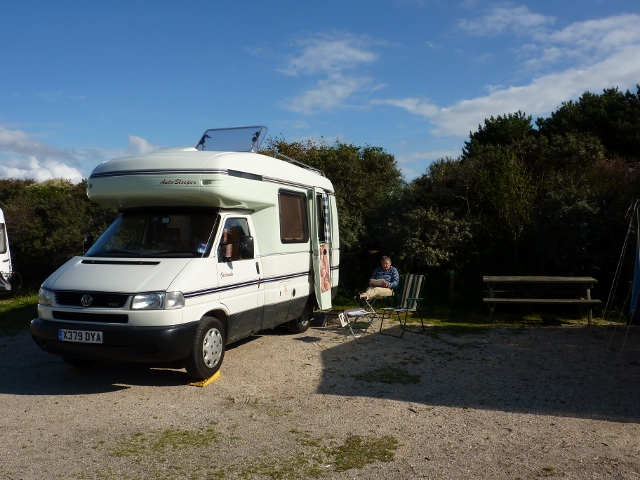 Still travelling north we changed our style of camping venue to what can only be described as civilised wild camping. Camping Bloemendaal borders the Kennemerland National Park and you pitch casually amongst the sprawling acres of sand dunes behind the beach of the North sea. Even the floor of the reception building is wooden slats laid on the sand. Fortunately, hidden among the small hills, grass and sand dunes are modern shower and toilet units. Surprisingly the tracks and pitch areas which are of sand and crushed shells are really firm. Out of view in the bushes you will find electric points and water taps.
Still travelling north we changed our style of camping venue to what can only be described as civilised wild camping. Camping Bloemendaal borders the Kennemerland National Park and you pitch casually amongst the sprawling acres of sand dunes behind the beach of the North sea. Even the floor of the reception building is wooden slats laid on the sand. Fortunately, hidden among the small hills, grass and sand dunes are modern shower and toilet units. Surprisingly the tracks and pitch areas which are of sand and crushed shells are really firm. Out of view in the bushes you will find electric points and water taps. 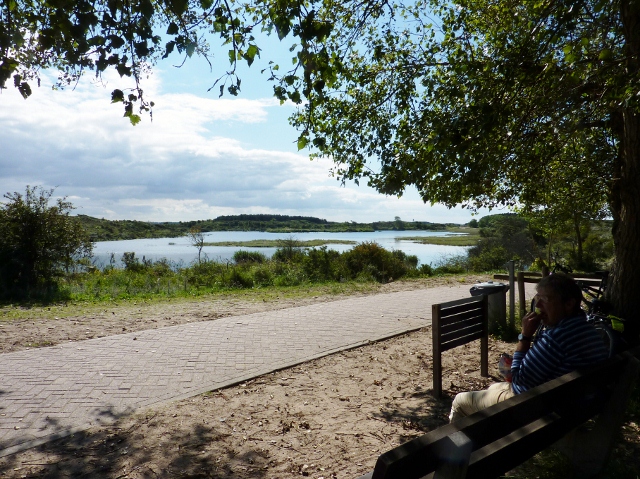 There are some lovely cycle rides in and around the Park itself with all the trails on hard surfaces and well marked, sometimes through woods other times in and around the dunes. Lots of resting places, several next to the central lake, make for welcome lunch-break stops. This being Holland the bike is king, so the enjoyment of its use is both natural and first class. On leaving this somewhat unusual site the still unpredictable wild weather called for a change of plans. Instead of our planned sea ferry over to the island of Texel we experienced the thirty kilometre drive along the barrier dam separating the now fresh water Ijsselmeer from the ever changing North sea. Looking out to the right there are good views out and across the huge lagoon but the seaward side was obscured by the upsweep of the dam. Seemed strange to come upon a fuel station and rest area half way across, not what you expect on a sea crossing. After a short northerly drive up the coast we swung east and parked our covered wagon on Bloemketerp Camping, a site very conveniently placed on the edge of the pretty town of Franeker.
There are some lovely cycle rides in and around the Park itself with all the trails on hard surfaces and well marked, sometimes through woods other times in and around the dunes. Lots of resting places, several next to the central lake, make for welcome lunch-break stops. This being Holland the bike is king, so the enjoyment of its use is both natural and first class. On leaving this somewhat unusual site the still unpredictable wild weather called for a change of plans. Instead of our planned sea ferry over to the island of Texel we experienced the thirty kilometre drive along the barrier dam separating the now fresh water Ijsselmeer from the ever changing North sea. Looking out to the right there are good views out and across the huge lagoon but the seaward side was obscured by the upsweep of the dam. Seemed strange to come upon a fuel station and rest area half way across, not what you expect on a sea crossing. After a short northerly drive up the coast we swung east and parked our covered wagon on Bloemketerp Camping, a site very conveniently placed on the edge of the pretty town of Franeker. 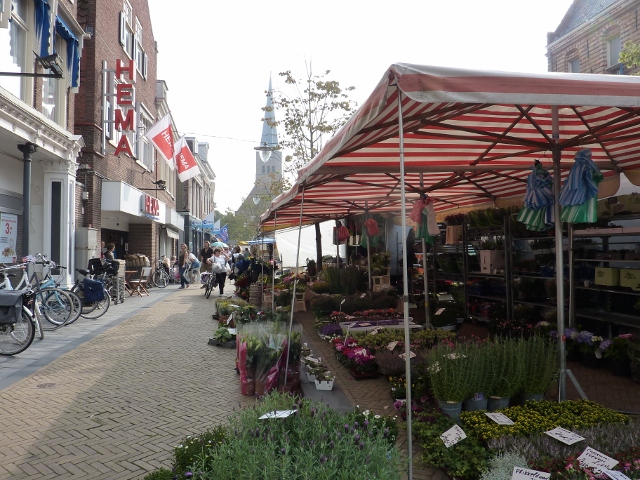 One of our leisurely strolls into town was rewarded by it being market day. The long pedestrianized (and the inevitable bicycle) shopping street had a variety of stalls selling fish, bread, cakes, sweets, flowers, fruit and vegetables, all looking quite tempting. A pleasant half hour walk alongside one of the many waterways is upon the earthen Ramparts, which circle the small town.
One of our leisurely strolls into town was rewarded by it being market day. The long pedestrianized (and the inevitable bicycle) shopping street had a variety of stalls selling fish, bread, cakes, sweets, flowers, fruit and vegetables, all looking quite tempting. A pleasant half hour walk alongside one of the many waterways is upon the earthen Ramparts, which circle the small town. 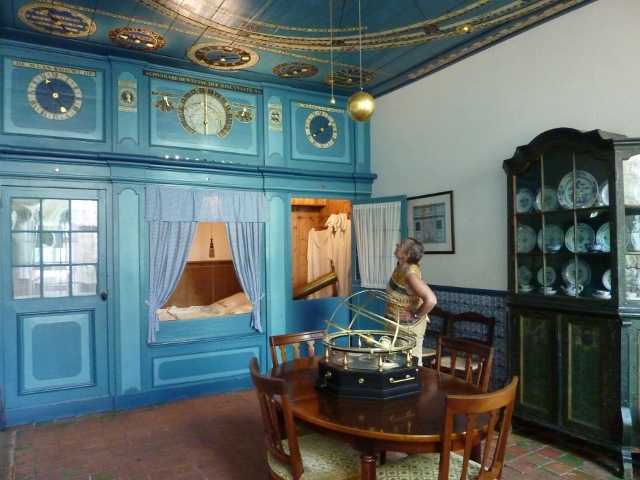
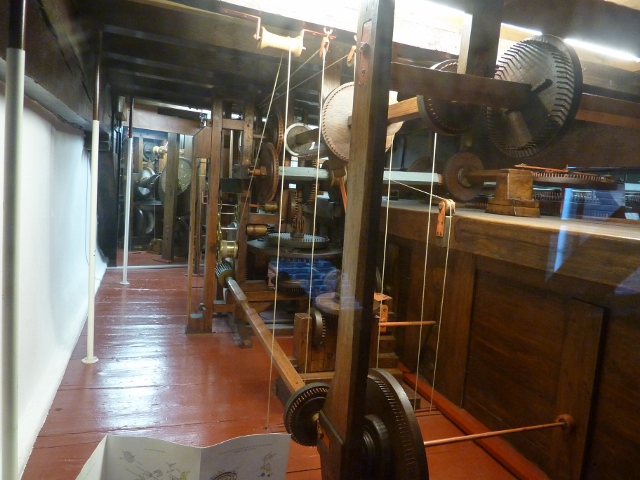 The highlight of our stay was the visit to the world’s oldest working Planetarium. Built in a modest little house by Eise Eisinga more than 220 years ago this is a remarkable piece of elaborate but sometimes simple piece of machinery. The workings (wooden gears made using hand wrought nails acting as teeth on a disc) occupied a floor space between the upstairs rooms and the couples ground floor living room. The impressive and decorative working display of Planets, calendars and time pieces fill the ceiling and upper walls in their living/bedroom. On our visit the curator conducted a very descriptive talk in English just for us, using the actual long pointing cane the inventor used all those years ago to show the local people that the world was not coming to an end, by the colliding of the planets, as was being forecast at the time. Like most of the small towns we had been visiting the houses and shops were mostly detached and had a unique Dutch character of their own. This made strolling the many canal-side streets quite easy on the eye.
The highlight of our stay was the visit to the world’s oldest working Planetarium. Built in a modest little house by Eise Eisinga more than 220 years ago this is a remarkable piece of elaborate but sometimes simple piece of machinery. The workings (wooden gears made using hand wrought nails acting as teeth on a disc) occupied a floor space between the upstairs rooms and the couples ground floor living room. The impressive and decorative working display of Planets, calendars and time pieces fill the ceiling and upper walls in their living/bedroom. On our visit the curator conducted a very descriptive talk in English just for us, using the actual long pointing cane the inventor used all those years ago to show the local people that the world was not coming to an end, by the colliding of the planets, as was being forecast at the time. Like most of the small towns we had been visiting the houses and shops were mostly detached and had a unique Dutch character of their own. This made strolling the many canal-side streets quite easy on the eye.  This was very true of the next northern village, Dokkum, once again the campsite, Harddraverspark, being on the edge and a few minutes walk over the canal bridges to the centre. The old part of Dokkum is a hexagonal shaped island reached by one of several bridges. There are so many bridges there is a cycling bridge-man who bikes between the many bridges announcing the next opening times or actually opening them in sequence for the many sea going yachts and Dutch barges. On two of the islands corners there are windmills, well cared for and quite picturesque. The short circular walk around the old part has its share of seating places to chill out and watch the water traffic, which we did. There are a couple of museums which alas were closed, as it was Sunday, but just leisurely walking the back streets and alongside the waterways can occupy a pleasant afternoon.
This was very true of the next northern village, Dokkum, once again the campsite, Harddraverspark, being on the edge and a few minutes walk over the canal bridges to the centre. The old part of Dokkum is a hexagonal shaped island reached by one of several bridges. There are so many bridges there is a cycling bridge-man who bikes between the many bridges announcing the next opening times or actually opening them in sequence for the many sea going yachts and Dutch barges. On two of the islands corners there are windmills, well cared for and quite picturesque. The short circular walk around the old part has its share of seating places to chill out and watch the water traffic, which we did. There are a couple of museums which alas were closed, as it was Sunday, but just leisurely walking the back streets and alongside the waterways can occupy a pleasant afternoon. 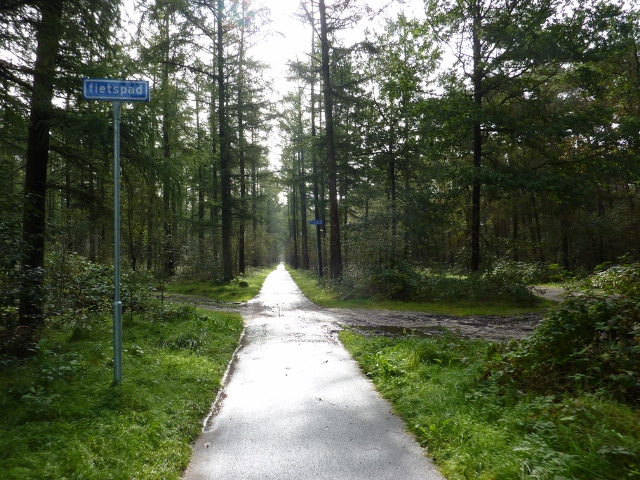 Heading our four wheeled home south the next few days were enjoyed on the quiet campsite De Norgerberg about a kilometre from the pretty village of Norg. The large pitches were set in small clearings in woodland. A good site with helpful, friendly English speaking wardens( as was the norm on the whole trip), they even give you a breathable ground sheet for your stay. . There are numerous walks and bike rides, all well marked, from the site. One walking nature trail took about an hour and half and has you looking for the next numbered marker before leaving sight of the last, could be fun with children, we did it in the rain, not quite so much fun.
Heading our four wheeled home south the next few days were enjoyed on the quiet campsite De Norgerberg about a kilometre from the pretty village of Norg. The large pitches were set in small clearings in woodland. A good site with helpful, friendly English speaking wardens( as was the norm on the whole trip), they even give you a breathable ground sheet for your stay. . There are numerous walks and bike rides, all well marked, from the site. One walking nature trail took about an hour and half and has you looking for the next numbered marker before leaving sight of the last, could be fun with children, we did it in the rain, not quite so much fun. 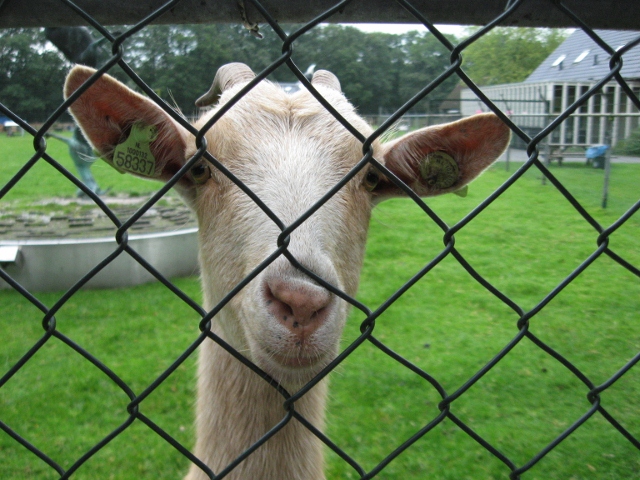 As the next day was hot and sunny it saw us on a bike ride to the small town of Roden, about seven kilometres away. Once again we were lucky to arrive on market day, food stalls selling tempting goodies filled the square. We tried the hot Waffles at a euro a piece, delicious. The ride back was again on good tracks mostly through the woods, on the way passing a small animal enclosure with goats, deer and even wallabies. Returning to Norg we were treated to it being an open day of the local Windmill, with its sails on and slowly turning it was a back in time moment. With the sun now our frequent companion we drove the short distance to last year’s favourite National Park and campsite at Dwingeloo. The next four days here saw us covering a lot of the same ground as before with the added experience of the open-air Folk Festival on the village green. Even though it was now September eating outside and shirtsleeve cycling was still the norm, as it was in June of last year.
As the next day was hot and sunny it saw us on a bike ride to the small town of Roden, about seven kilometres away. Once again we were lucky to arrive on market day, food stalls selling tempting goodies filled the square. We tried the hot Waffles at a euro a piece, delicious. The ride back was again on good tracks mostly through the woods, on the way passing a small animal enclosure with goats, deer and even wallabies. Returning to Norg we were treated to it being an open day of the local Windmill, with its sails on and slowly turning it was a back in time moment. With the sun now our frequent companion we drove the short distance to last year’s favourite National Park and campsite at Dwingeloo. The next four days here saw us covering a lot of the same ground as before with the added experience of the open-air Folk Festival on the village green. Even though it was now September eating outside and shirtsleeve cycling was still the norm, as it was in June of last year. 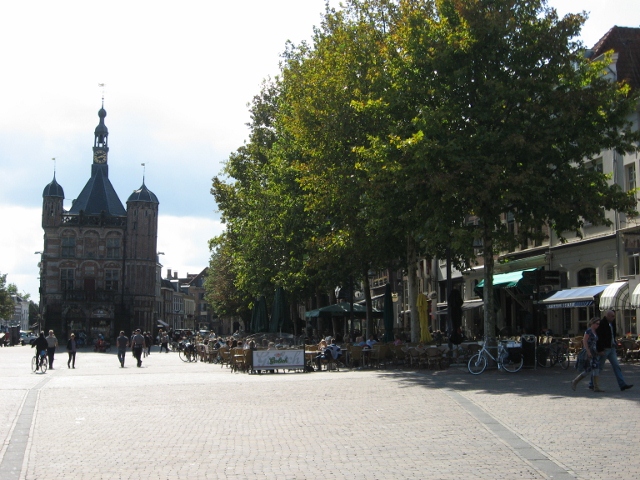 Still moving slowly south the next place to rest-up was the riverside town of Deventer. The campsite, again one of last year’s favourites, Stadscamping was quite a wet affair with one motor home having to be pulled off by tractor. A two minute walk from site and you are at the small passenger(and cycle) ferry over to the lovely old town itself (1.4 euro return). Once again we arrived for the huge busy and colourful street market. At one end of the market square stands the impressive old 16th.century weigh-house come Tourist Office come Museum. Hanging outside on a wall is a cauldron which was used in times past to boil alive wrong-doers, so the guide-book says. All around the main square are eating and drinking places with pavement seating to while away an hour or so . The old town is well preserved with narrow side streets full of small shops leading off from it and twisting their way towards the Ijssel River. Upstream of the ferry stands the bridge used in the film A Bridge Too Far, even though it depicted it was elsewhere.
Still moving slowly south the next place to rest-up was the riverside town of Deventer. The campsite, again one of last year’s favourites, Stadscamping was quite a wet affair with one motor home having to be pulled off by tractor. A two minute walk from site and you are at the small passenger(and cycle) ferry over to the lovely old town itself (1.4 euro return). Once again we arrived for the huge busy and colourful street market. At one end of the market square stands the impressive old 16th.century weigh-house come Tourist Office come Museum. Hanging outside on a wall is a cauldron which was used in times past to boil alive wrong-doers, so the guide-book says. All around the main square are eating and drinking places with pavement seating to while away an hour or so . The old town is well preserved with narrow side streets full of small shops leading off from it and twisting their way towards the Ijssel River. Upstream of the ferry stands the bridge used in the film A Bridge Too Far, even though it depicted it was elsewhere. 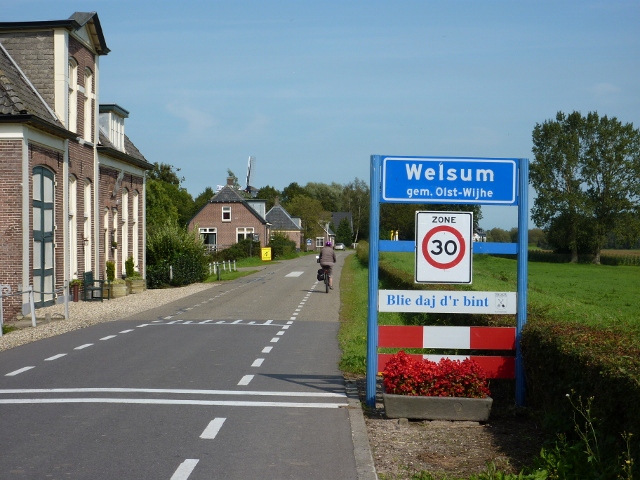 Anyone visiting here in good weather can enjoy, as we did, a lovely cycle ride for 25 kilometres on the elevated dyke track alongside the river to the windmill at Welsum and back. For the more adventurous you can carry on a bit further and catch the Olst ferry across the Ijssel and return on the other bank for a 32 kilometre round trip.
Anyone visiting here in good weather can enjoy, as we did, a lovely cycle ride for 25 kilometres on the elevated dyke track alongside the river to the windmill at Welsum and back. For the more adventurous you can carry on a bit further and catch the Olst ferry across the Ijssel and return on the other bank for a 32 kilometre round trip. 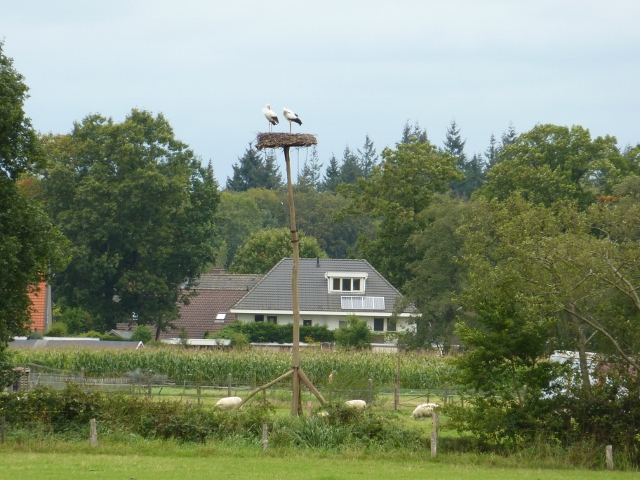 With a feel of autumn now in the air we headed south enjoying a few days of easy cycling and walking in and around the Veluwezoom National Park while at Robertsoord Camping at Eerbeek. On one ride we were fortunate to see a pair of White Stork high in a pole-top nest. These nesting platforms are often put up in farms and gardens as it’s deemed lucky to have the Storks breed on your land.
With a feel of autumn now in the air we headed south enjoying a few days of easy cycling and walking in and around the Veluwezoom National Park while at Robertsoord Camping at Eerbeek. On one ride we were fortunate to see a pair of White Stork high in a pole-top nest. These nesting platforms are often put up in farms and gardens as it’s deemed lucky to have the Storks breed on your land.
Archive
Categories
- Austria (4)
- Belgium (2)
- Bridges (1)
- Cold (1)
- Czech Republic (1)
- Denmark (1)
- England (9)
- France (11)
- Fun (2)
- Germany (2)
- Holland (4)
- Hot (1)
- Hungary (1)
- Italy (1)
- Leichtenstein (1)
- Luxembourg (2)
- Monaco (1)
- Roads and Bridges (1)
- Scotland (1)
- Slovenia (1)
- Spain (3)
- Sweden (1)
- Switzerland (8)
- Uncategorized (1)
- Wales (1)
- Weather (2)
Recent comments.
- Hazel on Rutland Water.
- George on Our 1st. Van “Escargo”…
- Bob campbell on Our 1st. Van “Escargo”…
- Hazel on Unusual vans we’ve seen.
- Karl Brenner on Sopron, Hungary 2006
- Cruizing Comet on End of an era…
- George on A favourite campsite.
Blogroll
